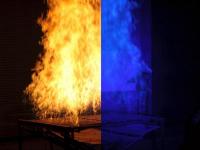Researchers at the National Institute of Standards and Technology (NIST) have demonstrated that ordinary blue light can be used to significantly improve the ability to see objects engulfed by large, non-smoky natural gas fires—like those used in laboratory fire studies and fire-resistance standards testing.
Tech
Chemical reactions take place around us all the time - in the air we breathe, the water we drink, and in the factories that make products we use in everyday life. And those reactions happen way faster than you can imagine.
Given optimal conditions, molecules can react with each other in a quadrillionth of a second.
Industry is constantly striving to achieve faster and better chemical processes. Producing hydrogen, which requires splitting water molecules, is one example.
Researchers at the National Institute of Standards and Technology (NIST) have demonstrated that ordinary blue light can be used to significantly improve the ability to see objects engulfed by large, non-smoky natural gas fires--like those used in laboratory fire studies and fire-resistance standards testing.
As described in a new paper in the journal Fire Technology, the NIST blue-light imaging method can be a useful tool for obtaining visual data from large test fires where high temperatures could disable or destroy conventional electrical and mechanical sensors.
MEDFORD/SOMERVILLE, Mass. (July 23, 2018)--Researchers at Tufts University School of Engineering have developed magnetic elastomeric composites that move in different ways when exposed to light, raising the possibility that these materials could enable a wide range of products that perform simple to complex movements, from tiny engines and valves to solar arrays that bend toward the sunlight. The research is described in an article published today in the Proceedings of the National Academy of Sciences.
SAN ANTONIO, Texas -- It sounds like science fiction: Nefarious genes clone themselves and settle their rogue copies in distant outposts of the galaxy (namely, our DNA), causing disease.
But it's a real phenomenon, and in research published July 23, scientists at UT Health San Antonio revealed that this genetic copy-and-paste activity is significantly increased in fruit fly models of tauopathies--neurodegenerative disorders that include Alzheimer's disease.
Generation of random numbers by measuring phase fluctuations from a laser diode with a silicon-on-in
WASHINGTON -- Researchers have shown that a chip-based device measuring a millimeter square could be used to generate quantum-based random numbers at gigabit per second speeds. The tiny device requires little power and could enable stand-alone random number generators or be incorporated into laptops and smart phones to offer real-time encryption.
Canada's provincial governments should mandate patient access to their electronic medical records, argue authors of a commentary in CMAJ (Canadian Medical Association Journal)
BIRMINGHAM, Ala. - Wrinkled skin and hair loss are hallmarks of aging. What if they could be reversed?
Two NASA satellites observed Tropical Storm Ampil in six and a half hours and found the storm's heaviest rainfall occurring in a band of thunderstorms shifted from north to south of the center. NASA's GPM satellite passed over the storm first and NASA's Aqua satellite made the second pass.
Tropical Storm Ampil was moving toward the northwest with winds of about 50 knots (57.5 mph) when the Global Precipitation Measurement mission or GPM core observatory satellite flew above on July 20, 2018 at 2:56 a.m. EDT (0656 UTC).
BELLINGHAM, Washington, USA and CARDIFF, UK - A paper published today in the Journal of Medical Imaging - "DeepLesion: Automated mining of large-scale lesion annotations and universal lesion detection with deep learning," - announced the open availability of the largest CT lesion-image database accessible to the public.
July 20, 2018--Supplemental oxygen eliminates the rise in morning blood pressure experienced by obstructive sleep apnea (OSA) patients who stop using continuous positive airway pressure (CPAP), the standard treatment for OSA, according to new research published online in the American Thoracic Society's American Journal of Respiratory and Critical Care Medicine.
This summer, NASA's Parker Solar Probe will launch to travel closer to the Sun, deeper into the solar atmosphere, than any mission before it. If Earth was at one end of a yard-stick and the Sun on the other, Parker Solar Probe will make it to within four inches of the solar surface.
Inside that part of the solar atmosphere, a region known as the corona, Parker Solar Probe will provide unprecedented observations of what drives the wide range of particles, energy and heat that course through the region -- flinging particles outward into the solar system and far past Neptune.
An international team of scientists has discovered a new, exotic form of insulating material with a metallic surface that could enable more efficient electronics or even quantum computing. The researchers developed a new method for analyzing existing chemical compounds that relies on the mathematical properties like symmetry that govern the repeating patterns seen in everyday wallpaper.
"The beauty of topology is that one can apply symmetry principles to find and categorize materials," said B. Andrei Bernevig, a professor of physics at Princeton.
The properties of a solid depend on the arrangement of its atoms, which form a periodic crystal structure. At the nanoscale, arrangements that break this periodic structure can drastically alter the behavior of the material, but this is difficult to measure. Recent advances by scientists at the U.S. Department of Energy’s (DOE) Argonne National Laboratory are starting to unravel this mystery.
A new combination of materials developed by Stanford researchers may aid in developing a rechargeable battery able to store the large amounts of renewable power created through wind or solar sources. With further development, the new technology could deliver energy to the electric grid quickly, cost effectively and at normal ambient temperatures.
